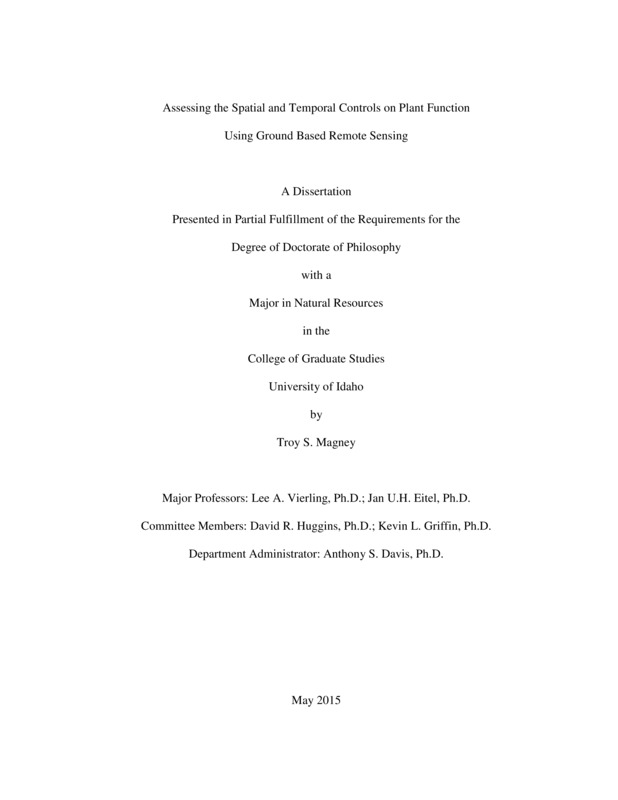Assessing the Spatial and Temporal Controls on Plant Function Using Ground Based Remote Sensing
Magney, Troy Sehlin. (2015). Assessing the Spatial and Temporal Controls on Plant Function Using Ground Based Remote Sensing. Theses and Dissertations Collection, University of Idaho Library Digital Collections. https://www.lib.uidaho.edu/digital/etd/items/magney_idaho_0089e_10612.html
- Title:
- Assessing the Spatial and Temporal Controls on Plant Function Using Ground Based Remote Sensing
- Author:
- Magney, Troy Sehlin
- Date:
- 2015
- Embargo Remove Date:
- 2016-05-12
- Keywords:
- LiDAR photochemical reflectance index photoprotection photosynthesis spectral reflectance xanthophyll cycle
- Program:
- Natural Resources
- Subject Category:
- Remote sensing; Plant biology; Ecology
- Abstract:
-
The global terrestrial carbon cycle is driven by the photosynthetic process, whereby chemical energy is created from a variable stream of solar photons that ultimately provide energy for life on Earth. Improved temporal and spatial monitoring of plant function for terrestrial biosphere modelling and management purposes rely heavily and increasingly on remote sensing systems; however, the interpretation of these data at leaf, canopy, and ecosystem scales require a nuanced understanding of vegetation structure and physiology. In this work, I seek to develop new and validate existing remote sensing techniques to map plant function in both space and time in the Palouse region of Eastern Washington, and the arctic tundra of Northern Alaska. From both an applied and theoretical framework, this work uses a variety of ground-based remote sensing tools to better understand how plants respond to their environment; and further, how aboveground biomass responds to environmental stressors via spectral reflectance measurements of the photochemical reflectance index (PRI) and the normalized difference vegetation index (NDVI). High resolution NDVI and PRI data were used to predict crop yield, biomass, protein concentration and nitrogen uptake in wheat, as well as track crop response to environmental conditions throughout the growing season. In the Arctic tundra, a 3-D plant canopy model derived from terrestrial light detection and ranging (LiDAR) measurements was coupled with a ray tracing model – demonstrating a new technique that reveals photosynthetic partitioning according to light availability within a small, Arctic shrub. In addition, a meta-analysis of xanthophyll cycle pool size (photoprotective pigments) on a global scale reveals patterns of xanthophyll accumulation coincident with extreme temperatures and water deficits, particularly in the Arctic tundra. This finding provides suggestions for how remote sensing techniques sensitive to xanthophyll cycle pool size may enable the eventual mapping of plant physiological status using spectral reflectance. To this end, it is my hope that this work provides techniques to enable an improved understanding of plant function across space and time, towards advancing the global mapping of photosynthesis - ultimately reducing uncertainties in not only the when and where, but also the why and how of land-atmosphere CO2 exchange.
- Description:
- doctoral, Ph.D., Natural Resources -- University of Idaho - College of Graduate Studies, 2015
- Major Professor:
- Vierling, Lee A; Eitel, Jan UH
- Committee:
- Huggins, David R; Griffin, Kevin L
- Defense Date:
- 2015
- Identifier:
- Magney_idaho_0089E_10612
- Type:
- Text
- Format Original:
- Format:
- application/pdf
- Rights:
- In Copyright - Educational Use Permitted. For more information, please contact University of Idaho Library Special Collections and Archives Department at libspec@uidaho.edu.
- Standardized Rights:
- http://rightsstatements.org/vocab/InC-EDU/1.0/

